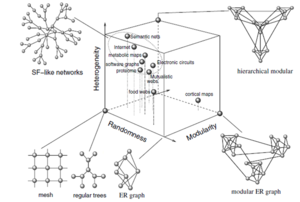Robustness of complex networks (project): Difference between revisions
From Santa Fe Institute Events Wiki
| Line 11: | Line 11: | ||
* ''Important papers about network generation are highlighted in bold'' | * ''Important papers about network generation are highlighted in bold'' | ||
* '''[http://www.barabasilab.com/pubs/CCNR-ALB_Publications/199910-15_Science-Emergence/199910-15_Science-Emergence.pdf BA Scale-free network]''' | * '''[http://www.barabasilab.com/pubs/CCNR-ALB_Publications/199910-15_Science-Emergence/199910-15_Science-Emergence.pdf BA Scale-free network]''' | ||
* [http://arxiv.org/pdf/cond-mat/0405381v2.pdf Random Networks with Tunable Degree Distribution and Clustering] | * '''[http://arxiv.org/pdf/cond-mat/0405381v2.pdf Random Networks with Tunable Degree Distribution and Clustering]''' | ||
* '''[http://people.maths.ox.ac.uk/maini/PKM%20publications/195.pdf How to generate Scale-free modular network using preferential attachment]''' | * '''[http://people.maths.ox.ac.uk/maini/PKM%20publications/195.pdf How to generate Scale-free modular network using preferential attachment]''' | ||
* '''[http://arxiv.org/pdf/cond-mat/0402009v1.pdf Scale-free networks with tunable degree distribution exponents]''' | * '''[http://arxiv.org/pdf/cond-mat/0402009v1.pdf Scale-free networks with tunable degree distribution exponents]''' | ||
Revision as of 17:50, 13 June 2012

Problem statement
Complex networks have various properties which can be measured in real networks (WWW, social networks, biological networks), e.g. degree distribution, modularity, hierarchy, assortativity etc. Robustness of complex networks is a big question, however only some progress have been done in this direction. For example, it was shown that the scale-free networks are much more topologically robust to random attacks than random networks. Many people claim that various characteristics of complex networks will influence the robustness interdependently. The question I am interested in is how?
Approach
The idea is to generate continuous topology space of various complex networks (networks with different modularity, degree distribution, hierarchy etc) and use it to measure their robustness (see Fig. 1). There are many approaches to measure the robustness of complex networks. For example we can remove edges of vertices of a complex network graph and look at the size of a giant cluster. We can discuss other possibilities.
If you are interested you can contact me directly or via my E-mail: krystoferivanov@gmail.com or via my discussion page in CSSS 2012 wiki.
Relevant literature
- Important papers about network generation are highlighted in bold
- BA Scale-free network
- Random Networks with Tunable Degree Distribution and Clustering
- How to generate Scale-free modular network using preferential attachment
- Scale-free networks with tunable degree distribution exponents
- Scale free networks with tunable clustering
- Error and attack tollerance of complex networks
- Structural Robustness of Complex networks
- Assortative mixing in networks
- Mean field theory to study scale-free networks
- Kroneker Graphs
- Exact maximum-likelihood method to detect patterns in real networks
- Biological robustness
- Attack vulnerability of complex networks
- Supply Network Topology and Robustness against Disruptions – an investigation using multi agent model
- Random graphs with arbitrary degree distributions and their applications
- Resolution limit in community detection - about a typical modularity measure and its limitations
- Add a relevant paper...
Learning Python
Participants
- Oleksandr Ivanov - krystoferivanov@gmail.com
- Ian Wood - ibwood@indiana.edu
- Xin Lu - xin.lu@ki.se
- Duenas-Esterling Marco-Antonio - maduenase@gmail.com
- Katrien Beuls - katrien@ai.vub.ac.be
- Cameron Ray Smith - c...@gmail.com
- Abigail Horn - abbyhorn@mit.edu
Source Control
I've set up a github repository for any python source we write here. To figure out how to use Git look here. Chapters 1,2,3, and 5 are particularly relevant, but I can run through the basics with anyone. It's useful to have a source control for both project coordination and backup, and git is very simple once you get the hang of it.
There is a shared folder on skype, please either sign your email in the participant list or drop a email to Xin Lu to access the generated network data. Dropbox link [1]
